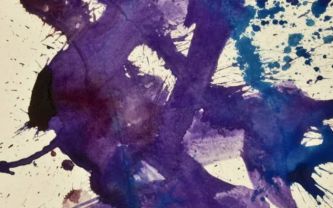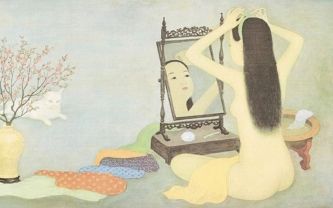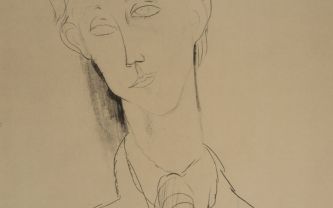Maroussia Tarassov-Vieillefon
Maroussia Tarassov-Vieillefon appraises your Russian paintings from the 18th to the 20th century with Auctie's.


If you own a work by or about the artist Alexandre Roubtzoff and would like to know its value, our state-approved experts and auctioneers can help you.
Our specialists will carry out a free appraisal of your work, and provide you with a precise estimate of its current market value.
Then, if you want to sell your work, we'll point you in the right direction to get the best possible price for it.
To date, Auctie's is the auction house that has sold the most paintings by the artist. Two paintings presented for sale in April 2024 caused a sensation, attracting numerous bidders from all over the world.
Whether portraits, such as Marie-Madeleine Leroy, which fetched €60,000, or the Portrait d'Arbia, which fetched €120,000, or landscapes, such as La mosquée Sidi Makhlouf, which fetched €13,500, Roubtzoff's paintings are more popular than ever on the French auction market.
Maroussia Tarassov-Vieillefon appraises your Russian paintings from the 18th to the 20th century with Auctie's.

A major Russian painter and Orientalist, Alexandre Roubtzoff is a sure bet on the art market. With his Russian origins and painting techniques, Roubtzoff has traveled the world and depicted landscapes far from his native land, making his work and artistic approach absolutely unique.
Today, his works are appreciated and highly sought-after in auction rooms. A work signed by Roubtzoff can fetch hundreds of thousands of euros at auction; his oil on canvas Bedouin of Tunis sold for €350,000 in 2010.
Technical | Estimate |
|---|---|
Drawing/watercolor | From €300 to €48,000 |
Oil painting | From €500 to €1,716,000 |


Admired for his Orientalist landscapes and portraits, Alexandre Roubtzoff began painting post-impressionist landscapes, influenced by the vibrant colors and play of light characteristic of this movement.
Attracted by the enchanting atmosphere of Tunis, the artist quickly became part of the Orientalist movement, led by Jean-Léon Gérôme. Jean-Léon Gérôme.
The latter inspired Roubtzoff in his quest for an authentic representation of the Orient, although Roubtzoff was careful not to lapse into outrageous exoticism.
Roubtzoff considers himself an "ethnographic" orientalist, meaning that his aim is to depict the Orient as truthfully as possible, far from the idealized landscapes often proposed by his contemporaries.
The traditions of the Orient, with their ancestral customs and scenes of daily life, become the common thread running through his works. His brushwork chronicles local lifestyles, capturing the essence of these cultures without superfluous embellishment.
Roubtzoff's paintings are luminous, inhabited by a palpable atmosphere that bears witness to his extended stay in Tunisia. His work is distinguished by the subtle contrast he creates between light and shadow, a mastery that earned him the nickname "painter of light" by Alexandre Fichet at the Salon Tunisien in 1920.
This play of light gives his works an almost tactile dimension, where the textures of stone, fabric and skin seem to vibrate under the Mediterranean sun.
His rich and varied repertoire is not limited to oil painting. Roubtzoff also produced numerous drawings and watercolors, often focusing on genre scenes or portraits. He excels in depicting faces and bodies, precisely capturing their expressions and postures.
The artist also produced studies and "academies", a term referring to a meticulous study of the morphology, details and musculature of male models in general, demonstrating his skill in anatomical observation.
These works reflect an almost scientific approach to his art, where every line, every shadow, is carefully studied to better convey the beauty of the human being and the world around him.

Alexandre Roubtzoff was born in St. Petersburg in 1884, in the heart of an imperial Russia where art played an important role. From an early age, he was supported by his aunt, an influential figure in his life, who recognized his precocious talent and encouraged him to follow a rigorous artistic training.
The passionate, diligent youngster soon attracted the attention of his teachers, who saw in him the promise of the future of Russian painting.
In 1904, at just twenty years of age, Alexandre Roubtzoff was admitted to the Imperial Academy of Fine Arts in Saint Petersburg, one of the most prestigious institutions of its time. This academy, renowned for the rigor of its teaching, offered him a complete and diversified training, nourished by the great Russian and European artistic traditions.
Roubtzoff studied art in all its forms, from the basics of academic drawing to history painting, via the study of the great masters. This strict but fruitful educational framework enabled him to develop an eclectic, personal style, borrowing from various influences while shaping his own path.
During these formative years, he acquired solid artistic and technical skills. Handling the brush, mastering light and shadow, and composing complex scenes quickly became his strengths.
His teachers also instilled in him the importance of detail and meticulous observation, qualities that would mark his future work.
While perfecting his skills, Roubtzoff learned to explore a variety of horizons, both thematic and stylistic, which would later enable him to adapt to different cultural and geographical environments, notably Tunisia, which would become his adopted homeland.


Alexandre Roubtzoff's Portrait d'Arbia is a striking work that testifies to his talent for capturing the essence and soul of his subjects. Painted with a certain delicacy, this portrait of a woman, probably from the local Tunisian population, perfectly embodies the artist's mastery of light and texture.
Here, the realistic depiction of Arbia is distinguished by a detailed rendering of traditional garments adorned with motifs and decorative elements, testifying both to Roubtzoff's respect for local cultures and his concern for authenticity.
When analyzing this work, one cannot help but think of the female portraits created by Orientalist artists such as Émile Deckers or Benjamin-Constantwho also sought to sublimate the female figure while exploring the exoticism of the Orient.
However, where some of his contemporaries might have succumbed to idealization or a form of colonial fantasy, Roubtzoff stands out for a more intimate, humanistic approach. Arbia's direct, melancholy gaze seems to reflect a genuine interaction between artist and sitter, a silent exchange that brings the portrait to life.
Like Delacroix, Roubtzoff succeeds in conveying the richness of oriental colors and fabrics while preserving a form of sobriety in the composition. The minimalist background, here neutral and uncluttered, highlights the central figure, accentuating the intensity of Arbia's gaze and the nobility of her posture.
Finally, the choice of colors, between reds, pinks and blacks, seems almost symbolic.
The colorful scarves and sparkling embroidered garments are a true celebration of local sartorial traditions, and the artist's meticulous attention to detail anchors Arbia in a setting that is both personal and cultural.
This portrait, while respecting the codes of orientalism, is distinguished by a more introspective dimension, where the model is not simply an exotic object of study, but a living, complex and profoundly human being.

Russian-born Orientalist painter Alexandre Roubtzoff is recognized and admired for his faithful depictions of landscapes and scenes of daily life in Tunisia, as well as for his portraits of colonial Orientalist society.
Unlike many of his contemporaries, who often idealized settings and people in an exotic style, Roubtzoff's constant concern for authenticity set him apart.
Rather than settling for stereotyped visions, he strives to immerse himself fully in the environment he paints, seeking to capture the soul of places and people with a deep respect for their traditions and realities.
His works, whether paintings, drawings or watercolors, are a precious testimony to the richness of artistic creation in Tunis between the wars, a period of great cultural effervescence.
In 1912, Roubtzoff received the crowning glory of his artistic training when he was awarded the prestigious Painting Prize of the Imperial Academy of Fine Arts in St. Petersburg. This distinction, a symbol of his immense talent, opened the doors to a wider world, thanks to a four-year travel grant.
His journey began in Spain, where he was immediately struck by the striking beauty of Andalusia. The light, colors and architecture of this region awakened in him a deep fascination with the Orient, fueling his desire to continue his exploration of other sun-drenched lands.
His peregrinations took him through several oriental countries, but it was finally Tunisia, in 1915, that captured his heart and became his land of choice. Seduced by the contrasts and diversity of its landscapes, he settled there for good, finding it a fertile ground for his artistic expression.
Despite his unshakeable attachment to Tunisia, Roubtzoff remains deeply attached to France. He regularly travels to Paris, the nerve center of the European art scene, where he takes part in major events.
In 1922, he was present at theMarseille Colonial Exhibition, where his work was acclaimed, as well as at the prestigious Salon d'Automne in Paris, which showcased the greatest names in modern painting. His dual membership of these two worlds, Tunisian and French, reflects the richness of his artistic career.
This to-and-fro between two cultures culminated in 1924, when he was granted French nationality, a symbolic act that definitively sealed his bond with his adopted country.
While Orientalist painting, triumphant in the 19th century, began to lose its lustre in the mid-20th century, particularly after Algeria's independence in 1962, Roubtzoff remained one of the leading figures of this movement.
Through his work, he continues to capture the Orient as he has perceived and experienced it, offering a unique vision imbued with a sincerity that remains the strength and originality of his work to this day.
Not all Roubtzoff's works are signed.
Like all artists, there are variations, and here is a first example of his signature at the bottom of this painting, signed and dated.

If you happen to own one of Alexandre Roubtzoff's works, don't hesitate to ask for a free estimate using the form on our website.
A member of our team of experts and certified auctioneers will contact you promptly to provide you with an estimate of the value of your work, as well as any relevant information about it.
If you're thinking of selling your work of art, our specialists will also be on hand to help you find alternative ways of selling it at the best possible price.

Kazuo Shiraga, the value of his surprising works
The value and history behind Kazuo Shiraga's powerful works. Our experts are on hand to provide you with an estimate in less than 24 hours.
Read more >

Rating and value of paintings, watercolors, Mai Th...
Mai Thu is a Vietnamese artist who has produced watercolors and silk paintings that are listed and valued on the auction market.
Read more >

Rating and value of Amedeo Modigliani's drawings
Amedeo Modigliani was an artist of the Parisian avant-garde who produced drawings whose value at auction is extremely high.
Read more >
Secure site, anonymity preserved
State-approved auctioneer and expert
Free, certified estimates